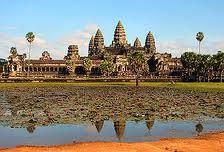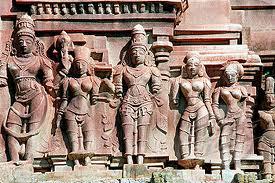After two rocking articles for ReflectionsPN (on Vietnam and Roger Federer), G. Veda Vyass is back with another guest article! Veda describes his trip to the temples of coastal Tamil Nadu in India and recounts his experiences, tells us a bit of history and explains how temples were such a boon in ancient civilisation. Enjoy the articles, and as always leave your comments below! Or, just shoot an email to [email protected].
Cheers!!
________________________________________________________________________________________
One needn’t be a staunch believer of God to go on a pilgrimage – or rather a temple trip. I am not a great fan of idol worship. I see God as one who looks at our actions and rewards us accordingly – better known as Karma. A week back, I went on a Temple Trip, to various temples dotting the coastal region of Tamil Nadu, with my family. We paid visit to various temples in and around Kumbakonam – the religious capital of Tamil Nadu.
There are close to 180-200 temples – big and small, around this small region of the state. Most of the temples had Shiva as their main deity and the rest Vishnu. These temples, predominantly built during the 10th-13th century, are structures that have lasted through many an adversity – torrential rains, heavy winds, scorching heat and various other natural disasters. These structures stand as a symbol of architectural excellence of the Indians a millennium ago.
One, must not only see these temples as a hub for religious activity or as architectural marvels – but also as a project, that kept the wheel of economy spinning. To put it in simpler terms, it was a source of income as well as a source that can pump in money back to the people. The King, who had revenues from trade, taxes, and various other means, instead of stocking up the money in the treasury, “invested” huge amounts of money in building temples and thereby employing architects, artisans, masons, carpenters and various other associated workers. Hence, the newly employed citizens of the country would have their pockets full at the end of the day, and they now went out to the market, and bought stuff that they need, thereby passing on the money to the vendors selling various commodities, and who in turn, visited temples, and dropped offerings that came back to the treasury. This way the Wheel Of Economy never stopped spinning, and so the King had the economy in check. That’s probably one of the reasons we don’t hear of “Economic Crisis” in the Indian History Books.

Brihadasweera Temple
Most of the temples look pretty new and beautified lately. Except for the exterior painting and the mural work done on the ceilings, nothing else has been touched upon at various places. The Sanctum Sanctorum has remained the same way, but for addition of some more gold to the deity’s person and the doors and other artifacts related to the deity. One is surely amazed at the sight of the carvings on the pillars and the walls. They are so symmetrical and make us wonder if there were machines then. I found a lot of resemblance to the workmanship to these temples and the ones at Angkor Wat, Cambodia. For people, who lesser know about Angkor Wat, it is the Largest Temple Complex in the World, built by Suryavarman II – who people reckon is of Indian origin. The Brihadeeswara Temple has stories of Shiva and Devas, and the Angkor Wat depicts stories of Ramayana and Mahabharata. What surprises us the most is that these structures have stayed for close to 9-10 centuries now, which is just mind-blowing, considering the maximum life of an apartment now would be no way greater than around 20-30 years.

The beautiful Angkor Wat Temple in Cambodia
How was this possible in an era where there were no dynamites to break rocks? You can find no mountains near the temples, yet huge rocks were brought here to build these temples. So, how was this possible? There was some mind that “engineered” this process. Although, these temples took close to 4-5 years to be built, they stood as a symbol of perfection. I guess there were no blemishes or any sort of imperfections when they were completed. These temples must be a collective effort of close to 10-15 thousand people. Almost all of King’s subjects were directly or indirectly involved in the construction process. So, that way, there is no question of “laziness” in the kingdom, and thereby eradicating “unemployment”. Heavy workload on the construction workers implied they would need extra energy, so this directly affects the peasants – peasants work more, grow more, sell more, earn more. So, we yet again spiral into the “Wheel Of Economy”. We can therefore see temples as vortices of money.
The intricacy in details of the carvings, the perfection in the sculptures, the size of the structures – these are unbelievable! The designs are copied to every pillar to the centimeter manually – which is just amazing, considering they had no machinery to aid them then. The Temples had Gopurams that narrated many stories. I observed a certain pattern in the tales in almost all the Gopurams – the lower-most tier of the Gopuram had sculptures of normal mortals, like us, how they got along with their life, and the different jobs that they did then. Family life, life at the workplace, etc are also sculpted – which was quite thoughtful of the architect, because, now, there was a person in me who actually observed it, and therefore History has been narrated. As you went higher in the Gopuram, you would find tales of Devas, Asuras, the Lord’s greatest devotees, the King himself at some point, and the top-most tier has the Lord along with his mistress, beautifully “looking down” at us.

Amazing sculptures of Indian temples
Later, invaders and subsequent rulers did their “best” to keep the temple strong by beautifying it with wall murals and adding deities to the temple. But for a very few temples that have got commercial attraction in the recent times, others are just waning out of people’s minds. Dark pathways, dimly lit Sanctum Sanctorum, and badly maintained temple premises lead to the decline in “fame”. Every temple forms a part of our heritage, then why the discrimination?
These are part of our history and were and always will be standing here projecting Indians’ excellence and thereby glorifying the nation. There’s a lot that one can learn from History, and the Temples prove to be great teachers. Let us be reminded at this point, that Temples were schools to the Brahmans – sad, they were the only ones who were being educated then.
Last but probably the most important to many, the Temples housed the Gods, which made the people feel secure, and God-fearing. The fear in people would generally reduce crime – not entirely though. Thus, the King has robbery, dacoits and other crime activities under check. Poets and scholars frequented to Temples to write in praise of the Almighty and seek his blessings, this indirectly developed literature.

A temple in ruins – we should make every effort to preserve them
Therefore, one must not only look at Temples from a religion’s point of view, but from a broader sense, they’re great teachers – and reflect to us the past. They were unique, and they could directly affect every citizen in some way or the other. To put everything in a nutshell, Temples are one of the greatest structures that were ever built and must be preserved by us for the generations to come.
19.075984 72.877656
